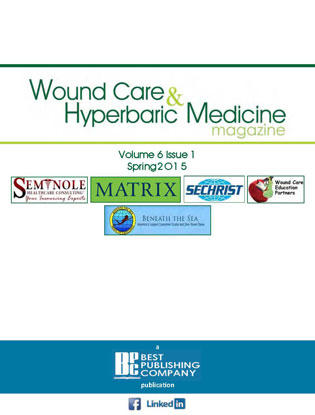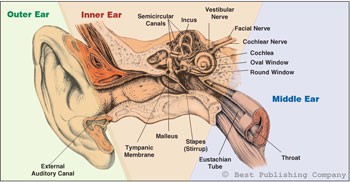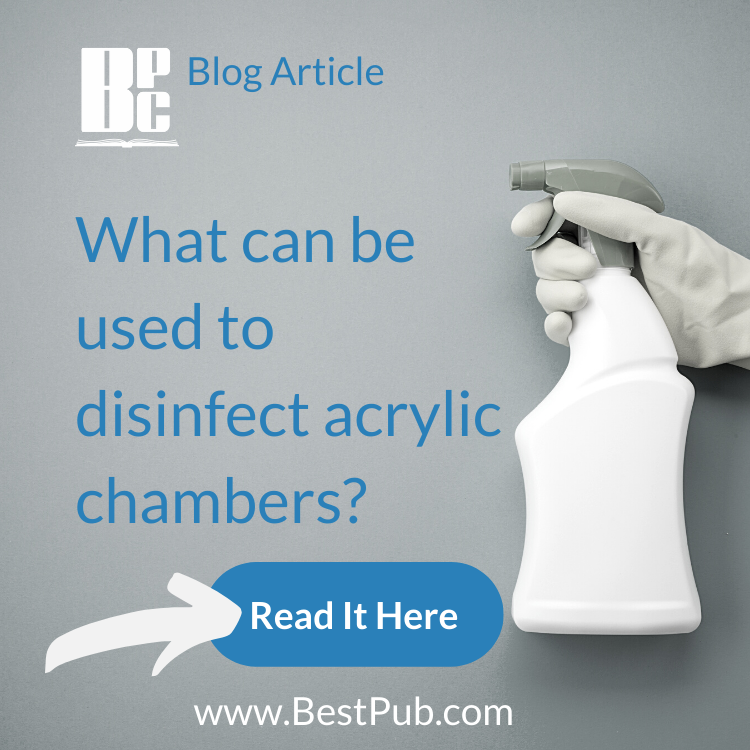DEPTH Blog
Sinus and Ear Disorders That Take Place During Hyperbaric Oxygen Therapy
Sinus and internal and external ear disorders are the most common side effects of hyperbaric oxygen therapy (HBO2).1 These spaces are the cranium’s pneumatic sockets and, particularly those of the middle and inner ear, are most frequently involved in the pressure stress caused by compression and decompression maneuvers during exposure to altered pressures in the hyperbaric chamber. Barotrauma is the mechanical tissue damage produced by environmental pressure variation, and the middle ear is the most frequently involved structure in this kind of damage. According to Boyle’s law (the product of pressure and volume is a constant for a given mass of confined gas) it is easy to understand why all enclosed air cavities are more susceptible to this kind of lesion. Barotraumas can occur due to an increase or decrease of gas volume. To avoid gas volume decrease during the compression phase, the patient must perform some compensatory maneuvers aimed at inhaling and forcing gas (air or oxygen) into the nasal and sinus cavities. During decompression in the chamber or even underwater, the body’s gas expands and is expelled from cavities to the outside, usually without any active maneuver. It is essential to teach the patient about the functions of the hyperbaric chamber and the correct maneuvers of baro compensation. In this article, we will describe the main barotraumas that can occur during hyperbaric oxygen therapy.
External Ear Barotrauma (EEB)
In normal conditions, the caliber of the external auditory canal is sufficient to allow immediate pressure compensation. An EEB can only happen if the external auditory meatus is blocked by an obstacle, such as impacted earwax, external otitis, or ear plugs, during chamber compression. In this case during compression the obstacle prevents the equilibration between outside and inside pressure. During the compression phase there is a reduction of volume both in the plugged external ear and in the middle ear spaces. This leads to edema and petechial hemorrhages of the auditory tube, middle ear, and tympanic membrane. Rare complications include ear bleeding and tympanic
perforation. Symptoms include acute pain, deafness, vertigo, nausea, and ear bleeding. The treatment therapy consists of antibiotics and topical steroids.
Middle Ear Barotrauma (MEB)
The most common side effect of HBO2 is middle ear barotrauma.2,3 MEB is more common during compression, while during decompression it is less likely to be reported. MEB during compression is a more pathological event and is related to a failed compensatory maneuver to relieve pressure between the middle ear and Eustachian tubes. The incidence of reported MEB varies between different hyperbaric centers from 5 to 66.7 percent.4,5 This difference is due to the heterogeneous population sample (intubated patients vs. spontaneous breathing patients) or to other causes.
Other common causes of MEB include the presence of diseases of the upper respiratory tract that generate obstructions of the Eustachian tube (e.g., infectious rhinitis and allergic and nonallergic rhinitis; ingestion of alcohol, which causes nasal congestion; large nasal polyps; large septal deviations; tobacco smoke; use of beta blockers and parasympathomimetic drugs; etc.) and incorrect or delayed compensation techniques. Depression of the middle ear tympanic membrane during the chamber compression begins to appear at a pressure of 1.2–1.3 atmospheres absolute (ATA) with reduction of the volume of endotympanic gas by 20-30 percent of the initial volume. There is a retraction of the tympanic membrane with pain, hyperemia, and edema of the ME mucosa that could lead to hemorrhage and cause the tympanic membrane to rupture. This generally produces a grade 1 or 2 MEB (according to the Teed classification) in more than 90 percent of patients; about 20 percent of patients with ear pain show tympanic membrane alterations short of perforation (MEB >grade 1). MEB is prevented in most patients by teaching autoinflation techniques or by use of tympanostomy tubes for those who cannot autoinflate their middle ear compartment. A prospective study in patients treated with HBO2 demonstrated that many patients develop serous otitis media during serial treatments. A history of Eustachian tube dysfunction predicted serous otitis media.6 Pseudoephedrine has been demonstrated to be effective in preventing barotitis media in a double-blind randomized controlled clinical trial in underwater divers.7 Conversely, topical nasal oxymetazoline hydrochloride was found to be ineffective in preventing middle ear barotrauma during HBO2.8
Other Complications
Sinus squeeze is the second most common in-chamber complication4 and usually occurs in patients with upper respiratory tract infections or allergic rhinitis. Usually a program of decongestant nasal spray, antihistamines, and/or steroid nasal spray just before compression allows the hyperbaric therapy to continue. Serious otitis has been reported in patients receiving hyperbaric oxygen therapy.6 Although once thought to be due to reduced middle ear pressure by oxygen resorption, there is evidence to suggest that hyperbaric oxygen therapy might cause a reversible derangement in a middle ear chemoreceptor reflex arc that may regulate
middle ear aeration.9
Hyperbaric Experience in Monoplace Chambers
Specific considerations for patients treated in monoplace chambers have been recently summarized in an analysis of adverse events using data from all Diversified Clinical Services centers operating for the period of 2009–2010.1 Diversified Clinical Services (now Healogics) provides management services to 340 hospital-based outpatient wound care centers, of which 89 percent provide outpatient hyperbaric oxygen treatment to diagnoses limited to those listed in the UHMS Hyperbaric Oxygen Therapy Indications. Adverse event data was collected concurrently in a central proprietary database.1 The primary adverse event categories were ear pain, confinement anxiety, hypoglycemic events, shortness of breath, seizures (including both oxygen toxicity and hypoglycemic event seizures), sinus pain, and chest pain. Reporting data was reviewed from 463,293 monoplace hyperbaric oxygen treatments provided in hospital-based outpatient settings involving 17,267 patients (an average of 27 treatments per patient). The majority of these patients received hyperbaric oxygen treatment for diabetic limb salvage or complications associated with prior radiation therapy. In 2009 there were 916 adverse events reported for 207,479 treatments in 7,871 patients, an overall adverse event rate of 0.44 percent. In 2010 there were 954 adverse events reported for 255,814 treatments in 9,396 patients, an overall adverse event rate of 0.37 percent. In order of decreasing rate of occurrence were ear pain (of any description), confinement anxiety, hypoglycemic events, shortness of breath, seizures (including both oxygen toxicity and hypoglycemiarelated seizures), sinus pain (of any description), and shortness of breath. There was no significant difference in the number or ranking of adverse events between 2009 and 2010. In this series of treatments, all patients received a standardized medical evaluation prior to initiating treatment, standardized pretreatment education, and a standardized assessment prior to each treatment. The consistent attention to detail may be the cause of such a low rate of complications.
About the Authors
Emanuele Nasole, MD, hyperbaric physician, Peschiera, Verona, Italy
Antonio Paoli, MD, BSc Associate Professor
Gerardo Bosco MD, PhD, Assistant Professor, Environmental Physiology and Medicine lab, Department of Biological Sciences, University of Padova, Italy
Enrico M. Camporesi MD, TeamHealth Anesthesia, Research Institute, Tampa General Hospital
References
1. Beard T, Watson B, Barry R, Stewart D, Warriner R. Analysis of adverse events occurring in patients undergoing adjunctive hyperbaric uoxygen treatment: 2009-2010 (Abstract). Undersea Hyperb Med. 2011;38(5):455.
2. Davis JC, Dunn JM, Heimbach RD. Hyperbaric medicine: patient selection, treatment procedures, and side effects. In: Davis JC, Hunt TK, eds. Problem wounds: the role of oxygen. New York: Elsevier; 1988. P. 225-35.
3. Davis JC. Hyperbaric oxygen therapy. J Intensive Care Med 1989; 4:55-7.
4. Bessereau J, et al. Middle-ear barotrauma after hyperbaric oxygen therapy. Undersea Hyperb Med. 2010. 37(4): 203-8.
5. Karahatay S, et al. Middle ear barotrauma with hyperbaric oxygen therapy: incidence and the predictive value of the nine-step inflation/deflation test and otoscopy. Ear Nose Throat J. 2008;87(12): 684-8.
6. Fernau JL, Hirsch BE, Derkay C, Ramasastry S, Schaefer SE. Hyperbaric oxygen therapy: effect on middle ear and Eustachian tube function. Laryngoscope 1992;102:48-52.
7. Brown M, Jones J, Krohmer J. Pseudoephedrine for the prevention of barotitis media: a controlled clinical trial in underwater divers. Ann
Emerg Med. 1992; 21:849-52.
8. Carlson S, Jones J, Brown M, Hess C. Prevention of hyperbaric-associated middle ear barotrauma. Ann Emerg Med. 1992; 21:1468-71.
9. Shupak A, Atias J, Aviv J, Melamed Y. Oxygen diving induced middle ear under-aeration. Acta Otolaryngol Stockh. 1995;115: 422-26.
About the Authors Emanuele Nasole, MD, hyperbaric physician, Peschiera, Verona, Italy Antonio Paoli, MD, BSc Associate Professor Gerardo Bosco MD, PhD, Assistant Professor, Environmental Physiology and Medicine lab, Department of Biological Sciences, University of
Padova, Italy Enrico M. Camporesi MD, TeamHealth Anesthesia, Research Institute, Tampa General Hospital
Find More Articles Like This
This article first appeared in Wound Care & Hyperbaric Medicine Magazine (WCHM) Volume 6 Issue 1 (Spring), 2015.
WCHM is the world's only free online publication covering the topics of wound care, hyperbaric and undersea medicine. Find all past issues and subscribe for free today! Click Here for more details...
 |
 |
When you subscribe to the blog, we will send you an e-mail when there are new updates on the site so you wouldn't miss them.







